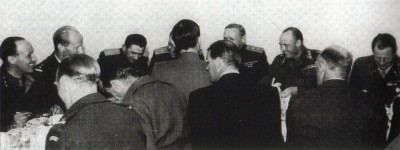As Norwegian and Russian officials gather near their shared border in the northern Norwegian city of Kirkenes this weekend, local residents fervently hope they’ll “break the ice” and improve diplomatic relations. They don’t want anything to damage the good relations they’ve enjoyed for years themselves with their Russian neighbors.

King Harald, Prime Minister Erna Solberg and Foreign Minister Børge Brende will be jointly commemorating the liberation of eastern Finnmark County 70 years ago with Russian Foreign Minister Sergej Lavrov and his delegation of Russian dignitaries. The liberation, made possible when Soviet troops crossed the border into Norway and fought back the country’s Nazi German occupiers, “unites us on something” despite current tensions, historian Stian Bones told Norwegian Broadcasting (NRK) earlier this week.
Russia’s role in allowing Kirkenes residents to fly the Norwegian flag for the first time since being invaded by Nazi Germany in 1940 also eased tensions in 1954, during the Cold War that followed World War II. The northern border between Norway and Russia had been “totally closed” for several years, Bnes noted, when the 10th anniversary of the liberation rolled around and brought with it “an air of reconciliation” after years of political tension.
Most residents of Finnmark, where many road signs are in both Norwegian and Russian, just want to stay friends with their neighbors over the border. “Those of us living up here have a completely different relation to Russia than folks in Oslo,” Willy Bangsund, a 69-year-old wrestling coach, told newspaper Dagsavisen recently. “Sanctions aren’t the way to go if we want to have peace. Dialogue and good contact is the only thing that matters.” Bangsund, who initiated wrestling matches between his students and Russian youth long before the end of the Soviet Union, said the most important thing isn’t the wrestling but “that Norwegian and Russian youth get to know one another and learn to understand each other’s culture.”
Historic ties
There’s been contact between Norwegians in Northern Norway and their Russian neighbours for centuries, going back to the so-called “Pomor trade” of the 1700s. The Pomors of northwest Russia would sail into Vardø with grain, for example, and head home with Norwegian fish. That continued until the Russian revolution in 1917. Since the collapse of the Soviet Union, relations have improved to the point where both Russians and Norwegians living within a 30-kilometer radius of the border crossing at Storskog can travel freely between the two countries.
In 1993, the “Barents Cooperation” was established through a declaration signed at Kirkenes, aimed at securing peace and stability in the region. The main job of the Barents Secretariat is to support Norwegian-Russian cooperation projects in the north, and nearly all local schools, associations and sports groups in Finnmark have taken part in some way. There’s even a Russian-Norwegian high school in Murmansk, which allows Norwegian and Russian youth to study together.
“It’s only the politicians that stir up all the craziness,” Bangsund, who was made an honorary citizen of Murmansk himself, told Dagsavisen. “Ordinary folks have always wanted to have contact with one another.”
Business concerns
Several local business leaders are also worried about the frosty relations between Moscow and the west at present. Trine Gustavsen and Aleksandr Vassiliev have enjoyed good times through their business venture that has factories both in Kirkenes and Murmansk. Their successful company produces lighting systems for the oil industry and airports, but Gustavsen fears the sanctions can ruin everything they’ve built up. “I’m frustrated,” Gustavsen told Dagsavisen. “Those of us here in Finnmark have to stand together and clearly let the politicians know that we disagree with what’s going on.”
Others recognize that Russia has become aggressive again of late, and that its violations of international law and human rights must be addressed. They also want their leaders in Oslo and Moscow, however, to know that they want to remain friends. Some told Dagsavisen they don’t feel threatened by the Russians’ recent military build-up and heightened fighter jet- and naval maneuvers off Norway. Seeing Russia use its power elsewhere, though, is cause for concern.

Prime Minister Erna Solberg, who was attending Saturday’s ceremonies regarding the liberation of eastern Finnmark, told newspaper VG this week, though, that one of the reasons Norway isn’t offering its own fighter jets to join military conflicts in Iraq and Syria, for example, is because of the “tense situation in our own areas. I’m thinking about the increased Russian activity both in the air and at sea, and the need to follow that closely here at home.”
Northern Norway’s rapidly expanding tourist industry also clearly wants to keep the peace in both Finnmark and Nord-Troms, buoyed by Lonely Planet’s recent claim that the stunning scenery in the area is among attributes making Northern Norway one of its top destinations for 2015 in its latest guide book.
The very fact that both the top Norwegian and Russian officials are going ahead with their long-planned meeting tied to the 70th anniversary of the liberation this weekend is a good sign, said Bones. There was also a ceremony early this week over the border in Litza, Russia, where more than 70,000 soldiers were killed during World War II. Norwegians and Russians were united there as well on Wednesday.
“The battles at Pechenga/Petsamo were very important for eastern Finnmark,” Norway’s former defense chief, Sverre Diesen, told NRK. “They led to Finnmark getting its freedom back several months before the rest of Norway.”
newsinenglish.no/Nina Berglund

